
Kyoto Prefecture is a prefecture of Japan located in the Kansai region of Honshu. Kyoto Prefecture has a population of 2,561,358 and has a geographic area of 4,612 square kilometres (1,781 sq mi). Kyoto Prefecture borders Fukui Prefecture to the northeast, Shiga Prefecture to the east, Mie Prefecture to the southeast, Nara Prefecture and Osaka Prefecture to the south, and Hyōgo Prefecture to the west.
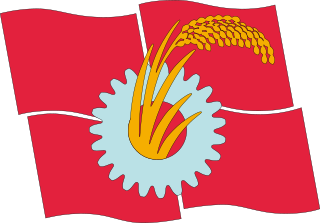
The Japanese Communist Party is a communist party in Japan. Founded in 1922, it is the oldest political party in the country. It has 250,000 members as of January 2024, making it one of the largest non-governing communist parties in the world. The party is chaired by Tomoko Tamura, who replaced longtime leader Kazuo Shii in January 2024.

Yukiko Kada is a Japanese politician and member of the National Diet of Japan, serving as member of the House of Councillors from Shiga Prefecture since 2019. She was the governor of Shiga for two terms from 2006 to 2014.

Kōji Matsui is a Japanese politician who was elected Mayor of Kyoto in 2024. Matsui was a member of the House of Councillors from Kyoto at-large district between 2001 and 2013, as a member of the Democratic Party of Japan. He served as Deputy Chief Cabinet Secretary in the Yukio Hatoyama Cabinet.
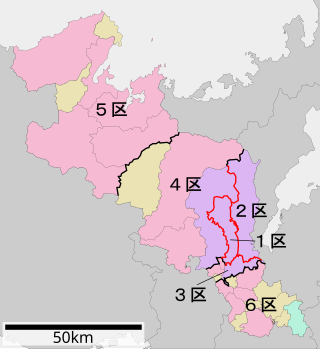
Kyōto 2nd district is a constituency of the House of Representatives in the Diet of Japan. It is located in central Kyoto and consists of the Kyoto city wards of Sakyō, Higashiyama and Yamashina. As of 2012, 267,926 eligible voters were registered in the district.

Kyōto 3rd district is a constituency of the House of Representatives in the Diet of Japan. It is located in South central Kyoto and consists of Kyoto city's Fushimi ward, the cities of Mukō and Nagaokakyō and the town of Ōyamazaki. As of 2012, 345,260 eligible voters were registered in the district.
The 17th unified local elections in Japan took place in April 2011. In the first phase on April 10, 2011, 12 governors, 41 prefectural assemblies as well as five mayors and 15 assemblies in cities designated by government ordinance were elected. In the second phase on April 24, 2011, mayors and assemblies in hundreds of cities, "special wards" of Tokyo, towns, and villages were up for election. Additionally, a by-election for the National Diet was held in Aichi on April 24.
Events in the year 2012 in Japan.

The Osaka Metropolis Plan or Osaka Metropolis was a plan to transform Osaka Prefecture from a fu, an urban prefecture, into a to, a metropolis. Under the initially envisioned plan, Osaka city, Sakai city, and other surrounding cities in Osaka prefecture, were to be dissolved and – similarly to the special wards of Tokyo – subdivided into special wards which had a status as municipalities but left some municipal tasks and revenues to the prefectural administration. As political resistance grew, notably the opposition to the plan in Sakai City expressed in the 2013 mayoral election, the concrete plan was reduced to, at least as a first step, only abolishing Osaka City. As in Tokyo, the metropolis would have continued to include all other municipalities of the prefecture and served as a prefectural government for them.
Politics of Osaka, as in all 47 prefectures of Japan, takes place in the framework of local autonomy that is guaranteed by chapter 8 of the Constitution and laid out in the Local Autonomy Law. The administration is headed by a governor directly elected by the people every four years in first-past-the-post elections. Legislation, the budget and the approval of personnel appointments, including the vice governors, are handled by the prefectural assembly that is directly elected by the people every four years by single-non transferable vote.
Politics of Osaka City, as in all municipalities of Japan, takes place in the framework of local autonomy that is guaranteed by chapter 8 of the Constitution and laid out in the Local Autonomy Law. As one of Japan's 20 major cities designated by government ordinance, Osaka City has some administrative responsibilities that are handled by the prefectures in ordinary municipalities and is subdivided into wards.

The 2012 Kyoto mayoral election was held on February 5, 2012. The incumbent mayor Daisaku Kadokawa won over a candidate backed by the JCP with a margin of 31,794 votes. It was considered that his first term was generally appreciated by the voters.
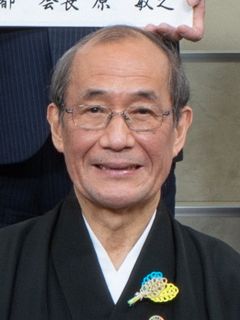
Daisaku Kadokawa is a Japanese politician and former mayor of Kyoto City, the capital city of Kyoto Prefecture.
Shortly after arriving in Kyoto, Japan for a 5-day bilateral meeting with Prime Minister of Japan Shinzo Abe, Prime Minister of India Narendra Modi and Prime Minister Abe announced the Kyoto-Varanasi Partner City Agreement. The text of the agreement was signed in the presence of the leaders of both nations by Mayor of Kyoto Daisaku Kadokawa and Ambassador of India to Japan Smt. Deepa Gopalan Wadhwa.
Several municipalities in the Canadian province of Quebec held municipal elections to elect mayors and councillors on November 3, 1985.
Kyoto Hemp Forum is a hemp industry event held in Kyoto. The first event was held in July 2016. Featured speakers included Japanese politicians first lady Akie Abe and the Mayor of Kyoto, Daisaku Kadokawa, as well as U.S. activist Chris Conrad and Dutch seed entrepreneur Ben Dronkers. The title of Conrad's book Hemp: Lifeline to the Future was also the official theme of the event. Exhibitors at the forum include an Australian hemp seed company whose biggest market is Japan.

The 2002 Kyoto gubernatorial election was held on 13 March 2002 to elect the next governor of Kyoto, a prefecture of Japan located in the Kansai region of Honshu island.
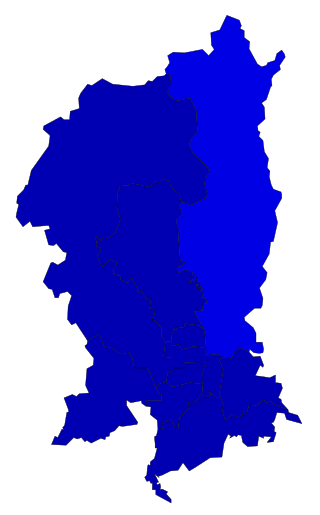
The 2016 Kyoto mayoral election was held on February 7, 2016. Incumbent mayor Daisaku Kadokawa ran for a third term, opposed by Independent and JCP politician Kumiko Honda and Independent Takashi Mikami. The total votes in the election were 398,988, a slight decrease in turnout compared to 2012. Kadokawa won by a wide margin compared to his 2012 election.

The 2020 Kyoto mayoral election was held on February 2, 2020. Incumbent mayor Daisaku Kadokawa ran for a forth term, against JCP-backed independent Kazuto Fukuyama and former Kyoto Party Independent Shōei Murayama. Kadokawa won by a margin of nearly ten points, making him one of the longest serving mayors of Kyoto.
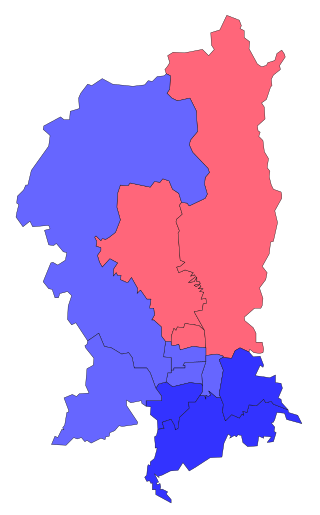
The 2024 Kyoto mayoral election was held on 4 February 2024. Incumbent mayor Daisaku Kadokawa did not run for a fifth term. Former Deputy Chief Cabinet Secretary Koji Matsui won by a slim margin of 3.48% against challengers Kazuhito Fukuyama, Shōei Murayama, and Shinji Ninoyu, two of which had run in the previous 2020 election.














